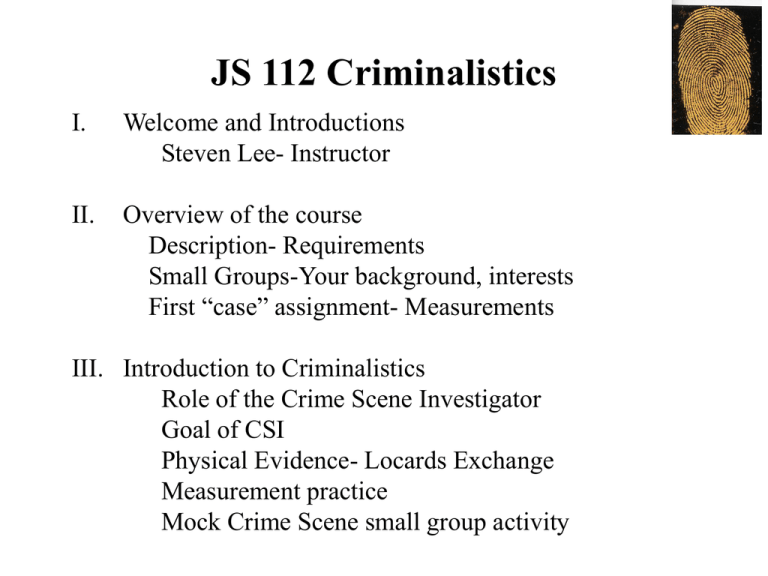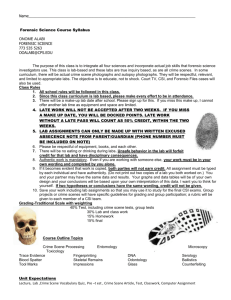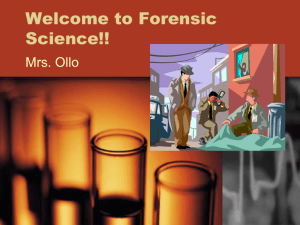
JS 112 Criminalistics
I.
Welcome and Introductions
Steven Lee- Instructor
II.
Overview of the course
Description- Requirements
Small Groups-Your background, interests
First “case” assignment- Measurements
III. Introduction to Criminalistics
Role of the Crime Scene Investigator
Goal of CSI
Physical Evidence- Locards Exchange
Measurement practice
Mock Crime Scene small group activity
My Background
• Who am I? Scientist, Teacher and Dad
–
–
–
–
–
Consultant -Director of R&D, Biotech (MiraiBio)
Adjunct Prof Chem FIU, Adjunct Prof Biology SFSU
Blessed to have been a mentor to my students
Husband and Dad to 4
Interests: music, running, meditation
• How did I get here? Research and Teaching
Experience
– CA DOJ DNA (94-99), Adjunct SFSU (96- ), Biology UNC (9294)
– SUNYB, AECOM, NYU, Columbia, UCB, UGA
– Courses: Mol Genetics, Genetics of Forensic DNA typing (UC
Davis), Chem. of DNA typing (Web Based- FIU- F 2001, Sp
2003)
• Forensic Experience? All in DNA
– CA DOJ DNA Research, Validation and Training
– Served on TWGDAM 1994-1999
Contact Information
Instructor:
Office
Office Hrs:
email
Phone
Dr. Steven Lee, Associate Professor
MH 521
MW 1445-1615 (W 1615-1715 email)
Set 15 minute appointments via email
Steven.Lee@sjsu.edu
sblee999@gmail.com
408-924-2948
Overview of the Course
• Course Description: This course will teach an
understanding of the fundamental theories of physical
evidence, practically applied; and the legal
consideration involved in its recognition, collection,
preservation and presentation in court. Physical
evidence includes such things as fibers, glass, hair, soil,
bullets, fingerprints, and shoeprints. Learn the
appropriate methods for processing, securing, and
isolating a crime scene. Topics include recording the
scene, searching for evidence, decision-making about
what evidence is appropriate and necessary to collect,
procedures for collecting physical evidence, and
maintaining the chain of custody to avoid
contamination.
Course Text and materials:
• Required Text:
– Criminalistics (10th edition) 2011. Saferstein. Pearson Prentice Hall.
– Required reading and internet materials:
– Journal articles and other readings will be accessible at the SJSU library, on
reserve or will be accessible on line. Citations and URLs for on line
materials will be provided in assignments.
– NIJ on line documents (eg: Crime scene investigation guidelines
http://www.ncjrs.org/pdffiles1/nij/178280.pdf, Crime Scene Investigator
Web sites- http://www.crime-scene-investigator.net/ and the CA Dept of
Justice Physical Evidence Bulletins:
http://www.cci.ca.gov/Reference/pehb/peb.html and other web sites will be
required.
Course Format:
• The course will include lectures by the
instructor and guest lectures from law
enforcment agencies. Discussions, videos,
small-group hands-on activities, and
hands-on crime scene exercises will also
be included throughout the semester. Online chat sessions if possible will also be
offered.
Course requirements:
• Exams: Three exams will be given in this course.
Exams will be cumulative and will include all
material covered up to the date of the exam.
Exams may include multiple choice, matching,
true/false, short answer, diagrams, drawings and
sketches, short essay and/or long essay.
• Exam 1: Wed 03/03/10
• Exam 2: Wed 04/07/10
• Final:
Mon 05/24/10
Quizzes and CSI exercises
• Quizzes on assigned readings, laboratories, small group
activities and other assigned materials will be given
during the semester. These will generally be multiple
choice, matching, true/false and short answer but may
also include essay questions. Total points=100
• Hands-on Crime scene Exercises /reports and
participation
• 3 hands-on crime scene exercises will be required. Each
will be worth 10 points. The format and grading of the
laboratory reports will be provided at the first laboratory
session. Bound notebooks are required for all laboratory
reports. Participation will be worth 20 points. Total
points= 50
Small group formation
8 per team- Designate one team leader
Gather emails and phone numbers
Find out the following. Total of 4 teams
1) Name, Year (class), Major
2) Why are you interested in forensic science
3) Something to remember you by- Hobbies,
Favorite food, favorite sport, other?
Grading
•
Quizzes
100 points
•
Exam 1
100 points
•
Exam 2
100 points
•
Final exam
150 points
•
Crime scene exercises 50 points
•
Total required
500 points
• A total of 10 points may be granted for small
group assignments and other individual
assignments during the semester. Each
assignment will be worth 1-2 points each. These
extra credit points may be used to augment your
final point total.
Grading Policies
• Make-up exams will not generally be permitted.
However, under extraordinary circumstances, with
proper documentation and approval by the
instructor, a 15 page single-spaced term paper of
an instructor assigned topic, may substitute for 1
exam.
• A+ 483.5 to 500
C+ 383.5 to 399.9
• A 467 to 483.4
C
367 to 383.4
• A- 450 to 466.9
C350 to 366.9
• B+ 433.5 to 449.9
D+ 333.5 to 349.9
• B 417 to 433.4
D
317 to 333.4
• B- 400 to 416.9
D300 to 316.9
•
F
<300
Course Schedule
•
•
•
•
•
•
15 weeks- No classes – Spring week 03/29-04/02
Exams : Wed 03/03/10, Wed 04/07/10, Final 05/24/10
Last class 05/17/10
CSI Exercises (tentatively scheduled) To be announced
Student Led Review dates: 03/01, 4/5, 5/17
Week of 02/22/10 Lee will be at the American Academy of
Forensic Science Meeting- Video and on line assignments in
class with required questions
• CSI Report due dates to be announced- All final reports will
be due on 05/17/10
Graduate students enrolling in
100 level courses
• Graduate students that are enrolling in
any eligible JS 100 course will need to
complete a special project and document
their completion. Only a total of 9 units
may be taken in this manner. Forms are
available at the graduate advisor office
(MH 508).
Course Add/Drop Statement
• Instructors are permitted to drop students who fail to attend
the first scheduled class meeting and who fail to inform the
instructor prior to the second class meeting of the reason
for any absence and their intention to continue in the class.
Some instructors will drop students who do not meet the
stated course prerequisites. However, instructors are not
required to drop a student from their course. It is the
student’s responsibility to make sure classes are
dropped.
• You, the student, are responsible for understanding the
policies and procedures about add/drops, academic
renewal, late drops, withdrawal, etc. found at:
http://sa.sjsu.edu/student_conduct
• http://info.sjsu.edu/web-dbgen/narr/soc-fall/rec-324.html
• http://www.sjsu.edu/sac/advising/latedrops/policy/
Academic Integrity and Plagiarism
• All students are required to read the following academic
integrity policy and complete a tutorial on plagiarism.
• Visit
http://www.sa.sjsu.edu/download/judicial_affairs/Academic_Integ
rity_Policy_S07-2.pdf and
http://sa.sjsu.edu/judicial_affairs/students/academic_integrity.html
for the academic policy and process
• Visit http://tutorials.sjlibrary.org/tutorial/plagiarism/index.htm for
the plagiarism tutorial
• Read each document in its entirety.
• You are required to document that you have read these policies by
printing out a copy of the quiz grade for the plagiarism
tutorial.
• For the academic integrity policy, you are required to hand in
a signed, dated, printout to me
• All due by class period 02/03/10
Assignments
• Group assignment 1. Gather your team emails and submit them to your team leader.
–
Team leaders should email me their team’s email addresses and cc copies to all their
teammates. Place the name of your team in the subject. Due by Sunday at 1200 noon
• Assignment 2 Due 2 Feb by email to Steven.Lee@sjsu.edu
• Part A. Read the following: http://www.crime-scene-investigator.net/respon1.html
• Read and discuss the Overview section and Pernonnel Duties and Responsibilities of this
URL (next time we will discuss personnel duties and responsibilities) among your team
mates.
• After reviewing write 3 quiz questions with a separate sheet for answers and
explanations. Total size of the document you submit should not be more than 3 paragraphs
(300 words of questions and answers). You may include 1 multiple choice question. Email
Qs and As to me
• Part B. Start to collect the following individually and with your team mates
• For each person:
1. Bound notebook with page numbers- Spiral notebooks are not as good as pages can easily
be torn our. If you need to use a spiral notebook, be sure every page is numbered. 1/person
2. Tape measure- 1 per person
3. Rulers and protractors (with metric and inches)- 1 per person
4. Graph paper (10 sheets/person)
5. Permanent sharpie markers (at least 2- black or blue)
6. Pens (ball points)
7. Digital Camera – 1 per team
Role of the Crime Scene
Investigator
– “Crucial” step in investigation
– Four Basic Fundamental Concepts
•
•
•
•
Secure- preserve evidence, safety
Search – Critical v Supporting v Property
Record – sketching, measuring, photography, videography etc
Reconstruct- final goal
– From the analysis of the crime, an experienced CSI will
determine what type of physical evidence, where and
how to recognize it, how best to collect, preserve and
process the evidence and combined with laboratory
examinations, reconstruct the crime
Crime Scene Notebook Guidelines
• Handouts on format
– Need to use proper format: Abstract, Introduction, Materials and
Methods, Results, Discussion with conclusions, References,
Appendices
• Handouts on Self Evaluation (Begin with the end in mind)
– Administrative Review
– Technical Review
• Examples of A, B and C Laboratory Notebooks
– You will have your notebooks at every class sessions
– At any session, I may select 1 notebook per group to “grade”. In
this way you will get feedback early in the semester to follow.
– I will be providing a portion of the CSI exercise grade from group
participation
Crime Scene Investigation
Goal- reconstruct the crime
Locard’s Exchange Principle
• Contact results in a cross-transfer of evidence
• 1910 Edmund Locard, successor to
Lacassagne as professor of forensic medicine at
the University of Lyons, France, established the
first police crime laboratory.
Overview of the types of Physical evidence
•
•
•
•
•
•
•
•
•
•
Blood, semen, saliva
Documents
Drugs
Explosives
Fibers, Hair, Paint
Fingerprints
Firearms and ammunition
Glass
Impressions
Organs and physiological
fluids
•
•
•
•
•
•
•
•
•
Pertoleum produts
Plastic bags
Rubber, other polymers
Powder residues
Serial numbers
Soil and minerals
Tool marks
Vehicle lights
Wood and other vegetative
matter
CSI Exercise 1- Measurements
and Documentation
• In your small teams using the rulers you have been
provided, measure to the nearest 0.1 mm the crime
scene object for your team.
• Team leaders should collect all measurements on
one paper. Write down the range of measurements
(eg 10.3-10.7mm) and calculate the average
measurement.
• In addition, take measurements to document the
location of the object.
• Once completed be sure everyone signs the paper
and hand it in.
CSI Measurement Questions
• Did you all agree on the measurements?
• If no, what are 3 reasons which may cause
the discrepancy?
• For one of the reasons, design an
experiment to test your hypothesis.
• Is there enough documentation for you to
reconstruct the location of the crime scene.
Office Hours Policies
• Set up 15 minute appointments by email
steven.lee@sjsu.edu
• Benefits (to you and me)
–
–
–
–
–
Review the course material.
Show me how hard you are working
Provide feedback
Ask specific questions or Ask for help
Extra credit may be provided for coming to discuss
questions on the reading, exams, DNA, assignments,
forensics, news articles, department, college and campus
scholarships…etc










